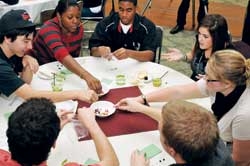Revealing diversity forum addresses looming racial shift
A handful of colored plastic can be a revealing representation of how much — or how little — diversity we have allowed in our lives.
That’s what students participating in the first Academic Center on Research in Diversity (ACCORD) undergraduate symposium discovered as they collected colorful beads representing people of varying ethnicity within their social circle.
Left with a handful of the same hue, some denied the reality. Others jokingly blamed “the system” for their colorless life. But all took away a powerful lesson.
“Now you do have a choice,” said Marie Amey-Taylor, associate director of ACCORD and assistant vice president of Human Resources. “Here you are at Diversity University. Will you gravitate toward what’s comfortable and familiar, or will you seek out diversity?”
As Amey-Taylor circulated among the students during the bead activity and later discussions, she witnessed the spark of awareness: “I do have choices, and even though it’s more comfortable to be with people who are like me, I can stretch my comfort zone a little bit, and interact with people that may not be just like me.”
Such epiphanies may be easier to express in the safe atmosphere of the symposium than the streets outside; whether the students act upon those realizations in the name of diversity is what matters, said Amey-Taylor.
And that was precisely the point of the session: raising students’ awareness about the country’s changing complexion.
As Roland Williams, Jr., director of ACCORD explained, the U.S. Census Bureau predicts Caucasians will become the national minority by 2042 when Latinos and Asians, followed by African-Americans, will surpass them in number. Even though this more racially and ethnically diverse nation isn’t due to develop until mid-century, Temple is preparing students now for the future they face.
“American identity has revolved around a color code,” said Williams, Jr., associate professor of English in the College of Liberal Arts. “What we have to do is reshape or even erase that color code and go with a new way of marking ourselves because what we’ve grown accustomed to will no longer be effective.”
And becoming accustomed to an African-American president, Latino Supreme Court justice or Asian federal transportation secretary is a good place to start thinking about reshaping our American identity, added Williams. After all, he said, America is considered the great "melting pot" for a reason.
"Immigrants made up this country, and we're richer for that," said Amey-Taylor. "We can capitalize on the strengths of being different, but just because there will be a numerical shift in the population majority doesn't mean the power will follow."
Instead, both Amey-Taylor and Williams agree there need to be more open ways to think about power and privilege sharing for all. And they believe events like the symposium will break down the barriers to diverse achievement and raise respect for diversity — even if it is one bead at a time.
